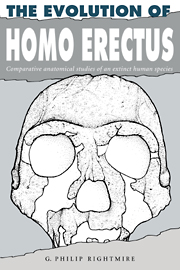Book contents
- Frontmatter
- Contents
- Preface
- 1 Introduction
- 2 Homo erectus in the Far East
- 3 Homo erectus at Olduvai Gorge
- 4 Discoveries from the Turkana basin and other localities in sub-Saharan Africa
- 5 Northwest Africa
- 6 Comparisons of African hominids with Asian Homo erectus
- 7 Homo erectus as a paleospecies
- 8 The transition to more modern forms
- 9 Summary and prospects for further research
- References
- Author index
- Subject index
4 - Discoveries from the Turkana basin and other localities in sub-Saharan Africa
Published online by Cambridge University Press: 14 October 2009
- Frontmatter
- Contents
- Preface
- 1 Introduction
- 2 Homo erectus in the Far East
- 3 Homo erectus at Olduvai Gorge
- 4 Discoveries from the Turkana basin and other localities in sub-Saharan Africa
- 5 Northwest Africa
- 6 Comparisons of African hominids with Asian Homo erectus
- 7 Homo erectus as a paleospecies
- 8 The transition to more modern forms
- 9 Summary and prospects for further research
- References
- Author index
- Subject index
Summary
Apart from the Olduvai remains, fossils referred to Homo erectus are known from several localities in sub-Saharan Africa. Some of the most important discoveries have come from the East Turkana sites in northern Kenya (see Fig. 19). Plio-Pleistocene sediments are exposed over a large region on the east side of the Turkana basin, and these deposits contain a wealth of bones and artifacts. Skulls and postcranial parts of Homo erectus have been found in several areas near Koobi Fora. The earliest of the fossils must be older than 1.6 million and perhaps as old as 2.0 million years, so these remains are more ancient than those from Olduvai. Other important material has been recovered from the western side of the lake basin at Nariokotome. Fossils from Lake Baringo, which lies to the south of Turkana, may also represent Homo erectus. In Ethiopia, the species is known so far only from isolated teeth or fragmentary specimens, mostly from excavations at Melka Kunturé. Affinities of the more complete cranium from Bodo in the Middle Awash Valley are still unsettled, but this hominid is probably best referred to another taxon.
In southern Africa, localities containing Acheulian stone artifacts do occur in some abundance, although many of the assemblages are surface scatters rather than sealed sites. Dating is frequently uncertain. It is likely that the earlier tools were made by Homo erectus, but traces of the people themselves are quite scarce. Only at Swartkrans are there fossils which seem definitely to represent this species.
- Type
- Chapter
- Information
- The Evolution of Homo ErectusComparative Anatomical Studies of an Extinct Human Species, pp. 86 - 118Publisher: Cambridge University PressPrint publication year: 1990

